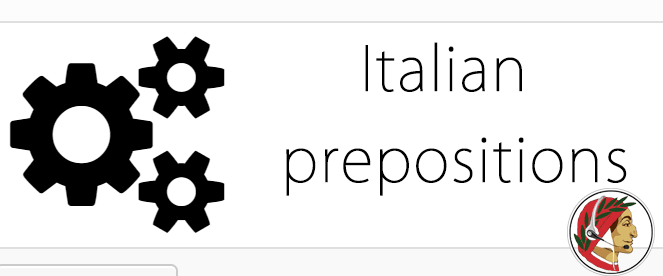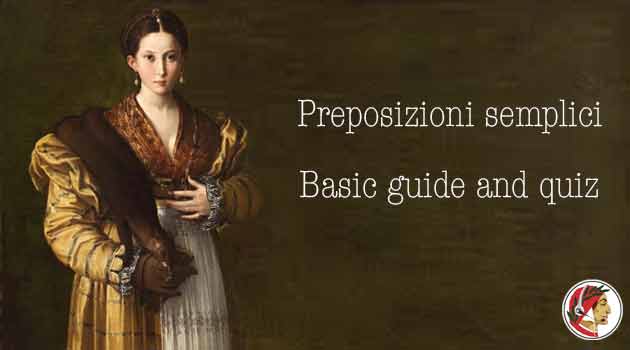Ecco un quiz impegnativo di livello intermedio sulle preposizioni semplici. Ciascuna pagina è dedicata a una funzione specifica delle preposizioni. 50 frasi in totale
In bocca al lupo!
Quiz-summary
0 of 5 questions completed
Questions:
- 1
- 2
- 3
- 4
- 5
Information
LOADING QUIZ...
You have already completed the quiz before. Hence you can not start it again.
Quiz is loading...
You must sign in or sign up to start the quiz.
You have to finish following quiz, to start this quiz:
Results
Time has elapsed
Your score is 0 out of 0 points, (0)
| Average score |
|
| Your score |
|
Categories
- Not categorized 0%
- 1
- 2
- 3
- 4
- 5
- Answered
- Review
-
Question 1 of 5
1. Question
Le preposizioni
Scrivi le preposizioni semplici mancanti, anche quelle non strettamente legate all'argomento
Preposizioni semplici di luogo
A - DA - IN - PER - SU - FRA
Abitiamo a Torino.
-
- La prossima estate speriamo (di) andare (in) vacanza (a) Capri.
- Passando (da, in, per) questa piazza, puoi arrivare facilmente (in) via Garibaldi.
- Facciamo raramente spese (in) centro perché abitiamo (in) periferia.
- Ti invito a cena (da) me domani sera. Abito (a) circa un chilometro (da) casa tua.
- Se non trovi le chiavi (in) camera (da) letto, devono essere (fra, tra, con) gli altri mazzi nel cassetto.
- Prima (di) abitare (a) Bologna, vivevo (in) un piccolo paese (fra, tra) Parma e Modena.
- Passeremo il Natale (da, con) mia madre, (in) una casa (in, su, fra, tra) quelle colline.
- Puoi appoggiare la giacca (su) quella sedia (in) fondo al corridoio.
- Ho incontrato Laura (per, in) strada e l'ho invitata (da) me (a, per) cena.
- Per lavoro, faccio avanti e indietro (fra, tra) Milano e Como durante la settimana.
Correct 26 / 26Points
Controlla le risposte e vai alla prossima domanda
↓↓↓
Incorrect / 26 Points
Controlla le risposte e vai alla prossima domanda
↓↓↓
-
-
Question 2 of 5
2. Question
Scrivi le preposizioni semplici mancanti, anche quelle non strettamente legate all'argomento
Preposizioni semplici di tempo
DI - A - DA - IN - PER - FRA
Non vado mai in centro di domenica.
-
- Se non ci vediamo (in) settimana, possiamo incontrarci (tra, fra) dieci giorni.
- (Di) lunedì c'è sempre un traffico bestiale (in) autostrada.
- Ho lavorato con Dario (per) quasi tre anni, ma non lo vedo (da) una vita.
- Se mi dici (a) che ora ti svegli, posso accompagnarti al lavoro (di) mattina.
- (tra, fra) due giorni finiranno le vacanze e (per) i prossimi tre mesi dovrò lavorare.
- (fra, tra) mezz'ora partirà l'aereo (per) andare Milano. Andrò e tornerò (in) giornata.
- (A) mezzanotte scatta l'ora legale. (Di) mattina ci sarà più luce. Sarà in vigore (per) i prossimi sei mesi.
- (Da) quando ti conosco, vai sempre (a) letto tardi (di) sera.
- (Da) domani cominciano le vacanze. (In) estate si esce sempre (di) sabato (per) andare a cena.
- La partita comincia (tra, fra) dieci minuti e (per) le prossime due ore non voglio essere disturbato!
Correct 25 / 25PointsControlla le risposte e vai alla prossima domanda
↓↓↓
Incorrect / 25 PointsControlla le risposte e vai alla prossima domanda
↓↓↓
-
-
Question 3 of 5
3. Question
Scrivi le preposizioni semplici mancanti, anche quelle non strettamente legate all'argomento
Preposizioni semplici di modo
DI - A - DA - IN - CON - SU - PER
Ascolto la radio a volume alto.
-
- Ci siamo incontrati (per) caso, mentre ero (di) fretta.
- L'insegnante spiega sempre (con) calma e (a) fondo.
- In chiesa si sta (in) silenzio e non si parla mai (a) voce alta.
- Ho indossato una tuta (da) meccanico (per) lavorare (in) modo pulito.
- Luigi veste sempre (con) gusto e indossa abiti fatti (su) misura.
- I tortellini (in) brodo si mangiano (con) attenzione perché scottano.
- I colleghi tengono l'ufficio (in) ordine per lavorare (con) precisione.
- Quel bambino parla già (da) adulto, (con) calma e (in) italiano corretto.
- Mio nonno guida (con) prudenza, mai (di) corsa.
- Non comportarti (da) stupido. Non capisco mai quando parli (per) scherzo.
Correct 22 / 22Points
Controlla le risposte e vai alla prossima domanda
↓↓↓
Incorrect / 22 Points
Controlla le risposte e vai alla prossima domanda
↓↓↓
-
-
Question 4 of 5
4. Question
Scrivi le preposizioni semplici mancanti, anche quelle non strettamente legate all'argomento
Preposizioni semplici di causa
DI - A - DA - CON - PER
Il concerto non si farà per la pioggia.
-
- Solo (a) vedere quanti piatti c'erano (da) lavare, volevo piangere (per) la disperazione.
- (Con, Per) tutto il vino che ha bevuto, Luigi è crollato (per) il sonno e si è addormentato (di) pomeriggio.
- (per, a) causa (di) un improvviso temporale, la lezione è stata interrotta (per) la mancanza di elettricità.
- Ero così felice (per) te che ho pianto (di) gioia (da) solo (in, a) casa.
- Ho una forte allergia (da) polline, (per, a) causa della quale continuo (a) starnutire.
- Mauro oggi è a casa (in, per) malattia.
- (per, con) questa brutta pioggia, è difficile andare (in) ufficio (in, per) tempo e (con) i vestiti asciutti.
- (A) forza di andare in palestra, le mie gambe fanno male (per) via dell'affaticamento.
- (Con) tutte queste preposizioni, la testa mi sta scoppiando (per) la confusione!
- (Con, Per) tutti i complimenti che le hanno fatto, Sara è arrossita (per) la vergogna.
Correct 27 / 27Points
Controlla le risposte e vai alla prossima domanda
↓↓↓
Incorrect / 27 Points
Controlla le risposte e vai alla prossima domanda
↓↓↓
-
-
Question 5 of 5
5. Question
ultima pagina
Scrivi la preposizione semplice giusta
DI - A - DA - IN - CON - SU - PER - TRA/FRA
-
- Non abbiamo intenzione (di) aspettarti. (Per) colpa tua, rischiamo (di) perdere l'aereo.
- Ho dimenticato l'ombrello (a) casa e adesso, (per) non bagnarmi, sono entrato (in) una stazione della metropolitana.
- Gigi, smettila (di) chiacchierare! Se non ti sbrighi (a) finire (di) mangiare quel minestrone, diventerà freddo.
- Ho perso il telefonino (di) mia sorella (per) una distrazione. Non potrò tornare (da) lei a mani vuote.
- (Con) soli mille euro non si può andare (in) vacanza (da) nessuna parte, tranne che (in) campeggio.
- (Per) finire quel lavoro (tra, in) una settimana, dovrò passare un paio (di) notti (in) bianco.
- Se tutti la smettessimo (di) andare (in) ufficio, avremmo più tempo (per) stare (con) la nostra famiglia.
- La città (di) Tokyo, con i suoi famosi fiori (di) ciliegio, accoglie turisti (da, di) tutto il mondo (in) primavera.
- È bello stare (a) casa (di) domenica (in) pigiama (a) fare colazione (con) la radio accesa.
- Molti italiani non hanno internet (a) banda larga e neanche una preparazione (di) base (per) poter lavorare (da, a, in) casa.
Correct 37 / 37Points
Controlla le risposte e il tuo punteggio finale
↓↓↓
Incorrect / 37 Points
Controlla le risposte e il tuo punteggio finale
↓↓↓
-





